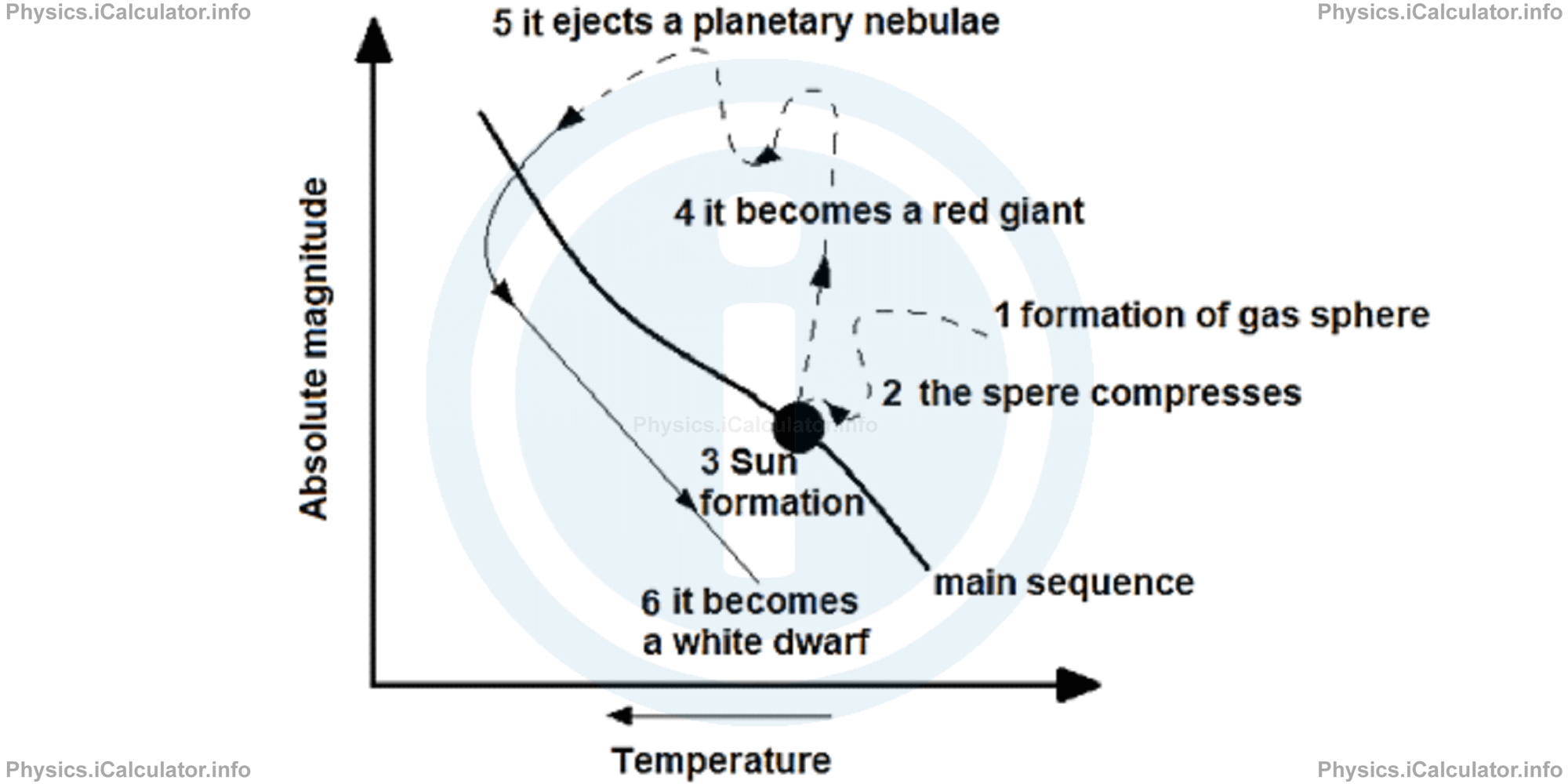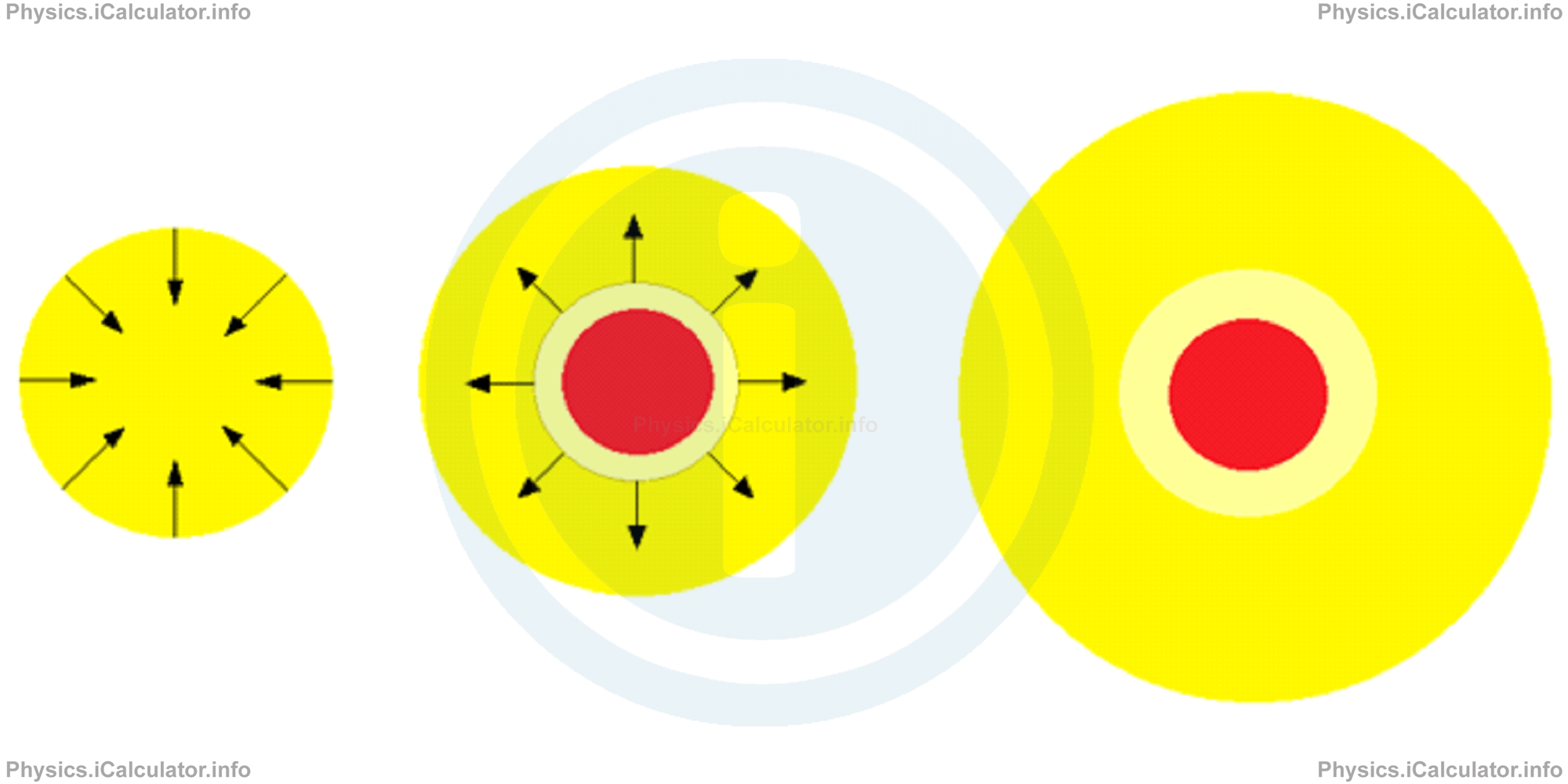Menu
Physics Lesson 22.5.1 - Evolution of the Sun and Similar Stars
Please provide a rating, it takes seconds and helps us to keep this resource free for all to use
Welcome to our Physics lesson on Evolution of the Sun and Similar Stars, this is the first lesson of our suite of physics lessons covering the topic of Evolution of Stars, you can find links to the other lessons within this tutorial and access additional physics learning resources below this lesson.
Evolution of the Sun and Similar Stars
The evolution of a star is very similar to that of a human being. A star is "conceived" from the compression of a large gas cloud, then it is "born" when thermo-nuclear reactions of fusion are activated. At this point, the star begins a long period of stable state which is part of its main sequence. In a certain sense, this stage represents the "adulthood" of a star. Then, the star gets old during the red giant stage and eventually terminates its life at the white dwarf stage or at another stage we will discuss later on in this tutorial. Now, let's take a closer look at each of these stages in more detail.
The Evolution and Lifecycle of a Star
Compresion of a large gas cloud [Conception]🠗
Thermo-nuclear reactions of fusion [Birth]
🠗
Stable State [Adulthood]
🠗
Red giant stage [Old Age]
🠗
White dwarf stage [Death]
a. Formation of a star
The formation (birth) of a star may occur inside any gas cloud. There are many such clouds in the Universe as ithe Universe contains very large amounts of hydrogen and helium in gaseous states not currently associated to any star or other celestial body. When there is enough gas available, it begins to collect in smaller volumes due to gravitational (attracting) forces. The more that gas collects around this "condensation" zone, the more gravitational force increases, attracting more gas from around. This process is similar to clouds formation in the sky.
The process of star formation is very long; it includes a number of factors where the most relevant are gravitation (which tends to attract matter and compress it inside the newly created sphere, and gas pressure (which increases with the increase in temperature of gas and tends to oppose the further compression of matter).
During the process of star formation the gas sphere becomes so large that the gravitational force at its centre increases the temperature up to several million Kelvin degrees. This is essential process that activates the thermonuclear fusion reaction during which hydrogen burns out converting into helium. This moment marks the formation or the birth of a star.
The position of star in the main sequence graph after its formation is determined by its mass; the most massive stars lie in the upper part of the main sequence graph in the H-R diagram. The figure below shows all possible stages of the Sun (past, present and future) where the process of formation has lasted for 30 million years.

b. Main sequence stage
All stars in the main sequence involve the thermonuclear reaction of hydrogen fusion at their centre. This process is very slow and balanced; hence, this is the longest stage of a stars life. For example, the Sun is estimated to exist in this state for approximately 10 billion years. The actual age of the Sun is about 4.5 billion years, so it is nearly at half of its life cycle. The rate of mass loss is small however; this makes the Sun very stable, i.e. its displacement rate in the main sequence graph is very close to zero.
The stars of the main sequence that are bigger than the Sun have a higher temperature in their core due to the larger pressure exerted on their core by the weight of star. This accelerates the rate of nuclear reactions. Hence, they radiate more energy than the Sun and are it in the main sequence H-R graph. (Sirius is an example of such stars.) They consume their inner sources of energy much faster and as a result, they have a shorter lifespan than smaller stars. For example, a main sequence star 50 times heavier than Sun has a lifespan of only a few million years, i.e. about 1000 times less than the Sun.
On the other hand, stars that have a mass of about one tenth of the Sun can live up to 20-30 billion years. This is because they have a lower temperature and pressure than the Sun due to the smaller weight they have to carry. This temperature however must be sufficient to initiate thermo-nuclear reactions of hydrogen fusion. Such reactions occur at a slower rate and as a result, the stars live longer.
c. Red-giant and super giant stage
When hydrogen (that acts as a nuclear fuel) in the central part of a star begins to drain out, the gas pressure starts to decrease gradually. As a result, the star starts shrinking (figure 1) as pressure (as an opposing effect to shrink) is smaller than before. Therefore, gravitational force prevails over the resistive forces and the equilibrium breaks down. Matter starts a very fast process of compression known as gravitational collapse. In other words, gravitational collapse is the contraction of an astronomical object due to the influence of its own gravity, which in turn, tends to draw matter inward toward the centre of gravity.
On the other hand, the new values of pressure created after the collapse bring an increase in temperature and as a result, hydrogen starts to burn out again in a spherical layer that surrounds the star core (figure 2). The energy produced in this process causes an expansion of external layers of the star as shown in the figure 3 below.

We can identify three zones in the second and third figure where the star is in red giant and at the red super giant stage. They are the red core (where helium is burned out), the spherical surrounding layer (where there is still some hydrogen burning out) and the outer (surrounding) layer.
Due to this process, the star magnifies in dimension in a very short time. When this occurs to our Sun, its outer layer will have reached the Earths' orbit and, as a direct result, melting everything on its surface. This occurs because the surface temperature will reach 2000-3000 K. The Sun eventually comes out of the stable phase and turns into a red giant. As explained earlier, helium will convert to carbon, oxygen, etc. In the case of our Sun, this stage will last for about 2 billion years, until it eventually burns out the entire reserve of helium.
d. White dwarf stage
From the processes described above, it is clear that the Sun is in the mature stage - it still has 71% hydrogen and 28% helium. When all hydrogen turns to helium, the stage of red giant will start. Then the red super giant stage will follow it until all helium reserves are exhausted. At this point the core of the Sun will only contain oxygen, carbon and helium. Due to the high gravitation, the core has a very high temperature and pressure. They, in turn, cause the Sun to eject outer layers into interstellar space. This mass leaving the star (and the Sun in the future) is called planetary nebulae (it has nothing to do with planets though). Consequently, the Sun will eventually lose an important part of its mass to the point where only the central core, made up mainly by carbon and oxygen, remains. These need much higher temperatures than the core temperature at this stage to burn out carbon and oxygen. As a result, thermonuclear reaction cannot occur anymore and eventually, the Sun turns into a white dwarf. It continues to illuminate and loses energy without having any source to replace it. Hence, it turns into a cold and is no longer an observable object. This marks the end of Sun and all the other similar stars in the main sequence which have a mass up to 10 times heavier than the Sun but not more. The life of heavier stars experiences other stages, which we will discuss in the next paragraph.
Example 1
The Sun consumes 600 million tons per second of hydrogen (actual rate). Would it continues burning hydrogen at this rate when it become a red giant? Take MSun = 1.989 × 1031 kg.
Solution 1
We know that 71% of Solar mass is hydrogen. This value corresponds to
= 0.71 ∙ 1,989 × 1031 kg
= 1.412 × 1031 kg
Hydrogen is consumed at an actual rate of R = 600 000 000 tons/s = 6 × 1011 kg/s. Hence, the time required to burn out the entire hydrogen at the actual rate is
= 1.412 × 1031 kg/6 × 1011 kg/s
= 2.353 × 1019 s
One year has 365.2422 days. When converted to seconds, this value becomes
= 31 556 926 s
≈ 3.156 × 107 s
Hence, the duration of the Sun in years in these conditions would be
= 2.353 × 1019 s/3.156 × 107 s/y
= 7.456 × 1011 years
This value corresponds to 745.6 billion years.
You have reached the end of Physics lesson 22.5.1 Evolution of the Sun and Similar Stars. There are 2 lessons in this physics tutorial covering Evolution of Stars, you can access all the lessons from this tutorial below.
More Evolution of Stars Lessons and Learning Resources
Whats next?
Enjoy the "Evolution of the Sun and Similar Stars" physics lesson? People who liked the "Evolution of Stars lesson found the following resources useful:
- Sun Feedback. Helps other - Leave a rating for this sun (see below)
- Cosmology Physics tutorial: Evolution of Stars. Read the Evolution of Stars physics tutorial and build your physics knowledge of Cosmology
- Cosmology Revision Notes: Evolution of Stars. Print the notes so you can revise the key points covered in the physics tutorial for Evolution of Stars
- Cosmology Practice Questions: Evolution of Stars. Test and improve your knowledge of Evolution of Stars with example questins and answers
- Check your calculations for Cosmology questions with our excellent Cosmology calculators which contain full equations and calculations clearly displayed line by line. See the Cosmology Calculators by iCalculator™ below.
- Continuing learning cosmology - read our next physics tutorial: Galaxies and Hierarchic Structures in the Universe
Help others Learning Physics just like you
Please provide a rating, it takes seconds and helps us to keep this resource free for all to use
We hope you found this Physics lesson "Evolution of Stars" useful. If you did it would be great if you could spare the time to rate this physics lesson (simply click on the number of stars that match your assessment of this physics learning aide) and/or share on social media, this helps us identify popular tutorials and calculators and expand our free learning resources to support our users around the world have free access to expand their knowledge of physics and other disciplines.